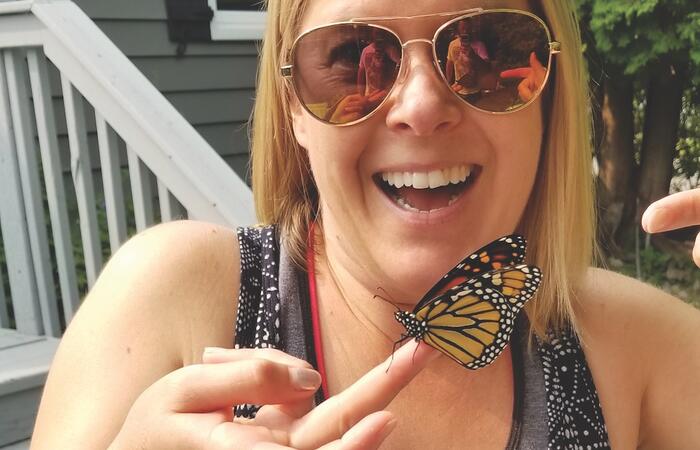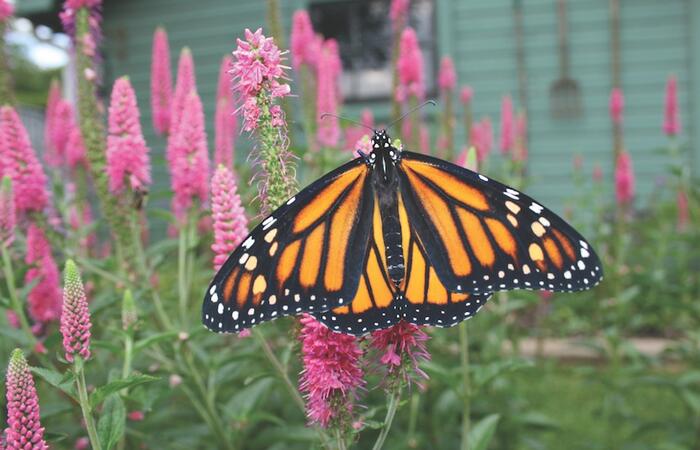Jodi Velasquez is the first to admit that her fascination with raising monarch butterflies, is well, a tad over the edge. “I’m the crazy butterfly lady!” she says with more than a twinkle in her eye. “I think I’m obsessed!”
It all started 5 years ago when Velasquez began preparing her yard to attract these beautiful winged insects to her house. “When I read that their populations were declining due to the use of pesticides, herbicides, and chemicals, and that their migratory path and winter habitat in Mexico was slowly being taken over by man, I wanted to do something.”
Velasquez created new perennial beds to attract the monarchs and planted mounds of flowers including lilies, gayfeather, foxglove, coneflower (Echinacea), bottlebrush, yarrow, chives, lilacs and blanket flowers that would provide the nectar the monarchs needed. “You have to have a garden that they’ll love and want to hang out and then lay their eggs,” Velasquez states. “And you have to have plenty of milkweed.”
Milkweed is an important food source for the monarch butterfly caterpillars who are able to digest the poisonous compounds in the sap and carry the toxins into their adulthood so predators learn to avoid the bitterness of this orange and black butterfly.
Although many regard milkweed as a very invasive flower, Velasquez feels differently. It took three summers of coaxing the tall stemmed, common milkweed with pinkish-purple blooms, and swamp milkweed with its characteristic light pink flowers, to grow in her garden before they were robust enough to become the caterpillar’s food source. When the garden was well established, Velasquez was all set.
“It’s like the saying in Field of Dreams,” she says. “You build it and they will come.” And they came.
In the first year Velasquez took in 8 caterpillars and provided foster homes for them inside her house. The caterpillars have many enemies including ants, wasps, beetles, spiders, and, of course, man. Chemicals used in neighbouring gardens can become airborne and lead to the young larvae’s untimely death. For this reason, Velasquez used a ready-made “Butterfly Habitat” from Toy Sense to create her first nursery for the 1 cm long caterpillars.
“You have to be dedicated when raising these little guys,” she says. And rightfully so. The front porch of the house, with its ample wide windows allowing for lots of sunlight, was made into a butterfly nursery and a strict feeding routine was established. “You have to be home to provide an ongoing supply of fresh milkweed. They’re a lot like teenagers. You turn your back and they’ve eaten you out of house and home!” Maintaining a clean indoor habitat is essential to preventing disease. Velasquez notes that “all they do is eat, nap, poop, repeat, so cleaning the
frass — the poop — daily will prevent the spread of bacteria and disease which can cause your caterpillars to die.”
Feeling a wonderful sense of accomplishment, Velasquez decided it was time to expand. Adding more perennials to her garden and increasing the number of nurseries from 1 to 3, she was able to raise 54 caterpillars this past summer.
The whole adventure has been quite therapeutic.
“I can spend hours watching them,” Velasquez says. “Eating their milkweed, growing, creating their chrysalis and then, almost magically, emerging from their chrysalis, pumping their wings to dry and get the blood flowing. It’s really quite wonderful. Truly wonderful. I wish I had discovered this type of therapy long ago.”
Perhaps the highlight of the whole experience is when the butterflies are ready to leave the safety of their first home and venture outdoors. Velasquez lifts the netting from their nursery, and ever so gently puts her hand inside so the butterfly can crawl onto her finger. Then, slowly and carefully, she brings the butterfly outside and places it near the milkweed bed to enjoy it’s first meal.
At this moment each of the butterflies is given its name.
“I do the Jane Goodall thing when she named the chimpanzees in each troop using the same first letter. This past summer all of the butterflies in my first group that I released in July began with the letter ‘C’. There was Clara, Clarisse, Clementine, Cleo, Clarke, Clay and Clayton. The next group all began with the letter ‘F’ and finally the third group all began with the letter ‘L’: Lantana, Lara, Larkspur, Laurabelle, Laurel, Lafayette, Laurentian, Leopold, Lincoln... “And it’s easy to tell the males from the females. The males have a distinctive black dot on each of their hind wings.”
And the cycle will continue. The next generation of butterflies will return in the summer – along with many others – to lay their eggs in Velasquez’s yard and Velasquez will be ready to provide the young caterpillars with a safe home. A little bit of a safe haven in exchange for some therapy. A win-win situation for everyone.
Velasquez is very thankful to monarch butterfly experts and enthusiasts Barb Kuschak and Dan Fulton, who have provided her with much needed knowledge and advice. For more information about groups who share Velasquez’s enthusiasm for monarch butterflies go to: www.facebook.com/ groups/TheBeautifulMonarch/www.ontario.ca/page/monarch





